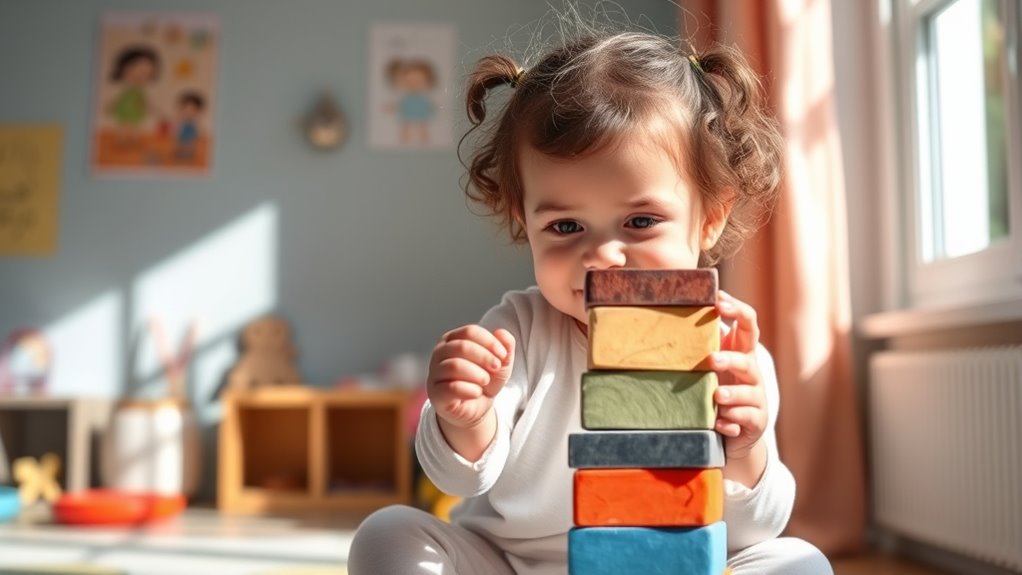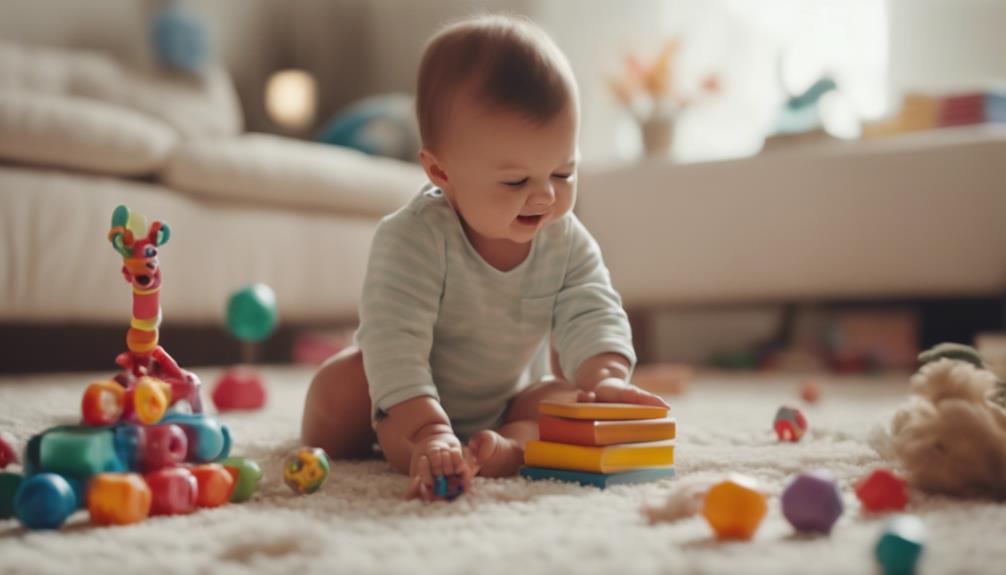Toddlers love repetition because it helps them explore their world, build confidence, and feel secure. When they repeat activities, they strengthen neural pathways, making learning easier and boosting their skills in motor, language, and problem-solving areas. Repetition also provides comfort through familiar routines and fosters emotional resilience. By repeating activities, your child gains mastery and independence. Keep exploring these simple routines, and you’ll discover more about how repetition fuels your toddler’s growth and development.
Key Takeaways
- Repetition helps toddlers explore and understand their environment, building neural connections and reinforcing learning.
- Doing things over provides a sense of security and comfort through familiar routines and activities.
- Repetition boosts confidence as children master new skills and gain control over their actions.
- Repeating activities enhances language development, memory, and vocabulary recognition.
- It supports emotional resilience by creating predictable, calming experiences that foster trust and stability.
Understanding Why Toddlers Seek Repetition
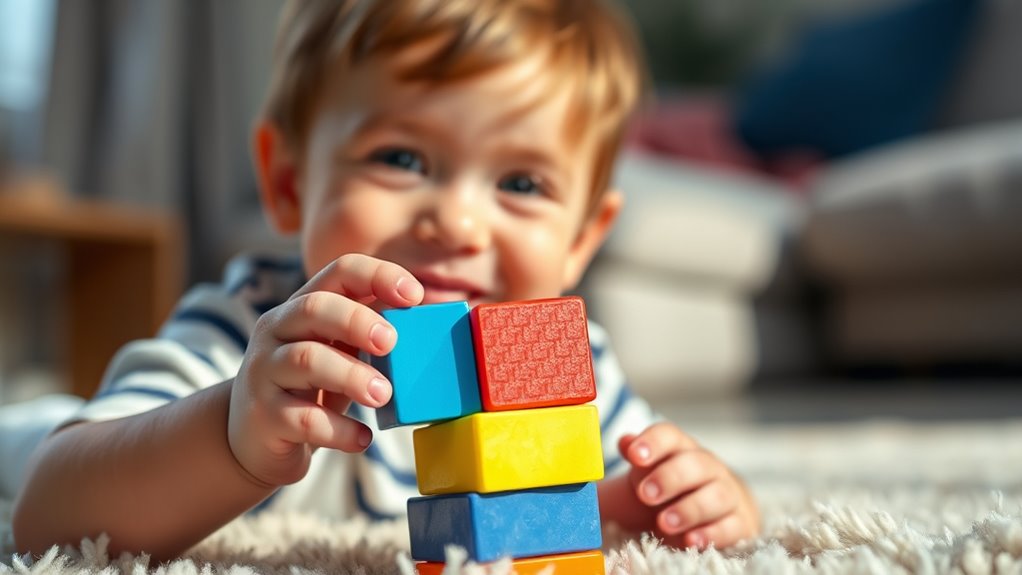
You might notice that your toddler constantly repeats the same actions or phrases, and understanding why can help you respond more effectively. Repetition is a natural part of their sensory exploration, allowing them to gather information through their senses and better understand their environment. It also serves as a way for toddlers to express their emotions; repeating a favorite song or action can comfort them or show excitement. This behavior helps them build confidence as they master new skills and gain control. By engaging in repetitive activities, your toddler feels safe and secure, reinforcing their emotional well-being. Recognizing this, you can support their development by providing safe opportunities for sensory exploration and emotional expression, fostering confidence and curiosity. Additionally, understanding the role of AI in media and entertainment can inspire creative ways to incorporate engaging, repetitive activities through technology that enhance learning and enjoyment. For example, mindfulness techniques such as deep breathing and visualization can help soothe children during moments of overstimulation. Recognizing the importance of repetitive behaviors can also guide parents in creating enriching environments that cater to these natural tendencies. Moreover, integrating educational technology thoughtfully can further encourage positive developmental behaviors while respecting their need for repetition.
The Role of Repetition in Brain Development
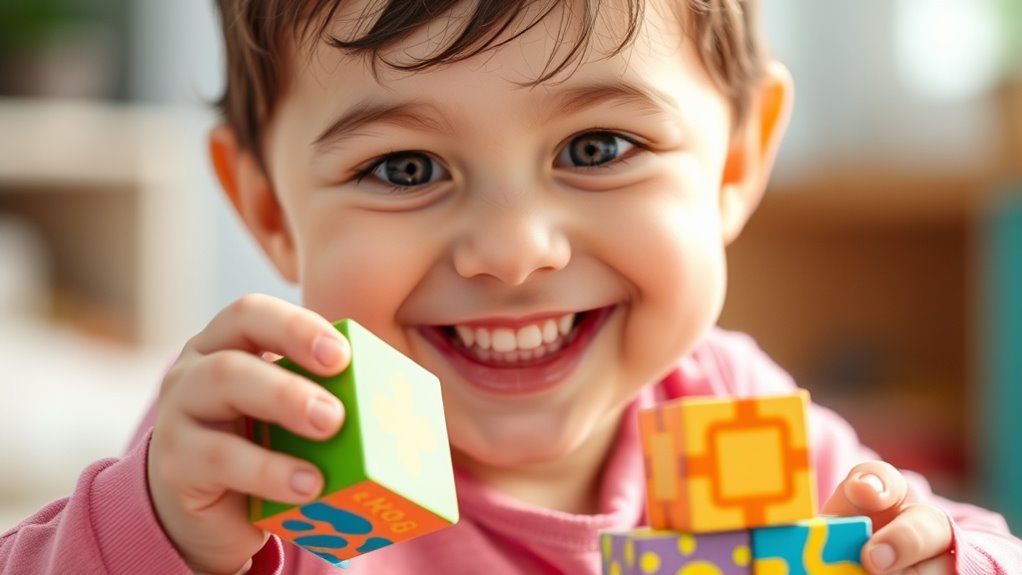
Repetition plays a vital role in shaping a toddler’s brain development, helping establish neural connections that form the foundation for future learning. When you repeat actions or words, you promote the growth of neural pathways, which are essential for the brain’s information processing. This process helps toddlers recognize patterns, develop motor skills, and understand language. The more they repeat activities, the more their brains wire these pathways, solidifying foundational knowledge. For example, incorporating multifunctional furniture in a living space can encourage children to engage in various activities within a limited area, fostering adaptability and cognitive development. Additionally, engaging in internal company hackathons can stimulate problem-solving skills and teamwork, which are crucial for cognitive growth. Regular repetition also supports the development of repetition-dependent learning mechanisms, which are fundamental for mastering complex skills. Research indicates that neural plasticity is greatly enhanced through repetitive practice, making learning more efficient. Consistent practice helps strengthen the neural connections involved in skill acquisition and retention. Without repetition, neural pathways remain weak or incomplete, hindering learning. So, by encouraging your child to repeat activities, you’re actively supporting their brain’s capacity to learn, adapt, and grow.
How Repetition Builds Confidence and Security
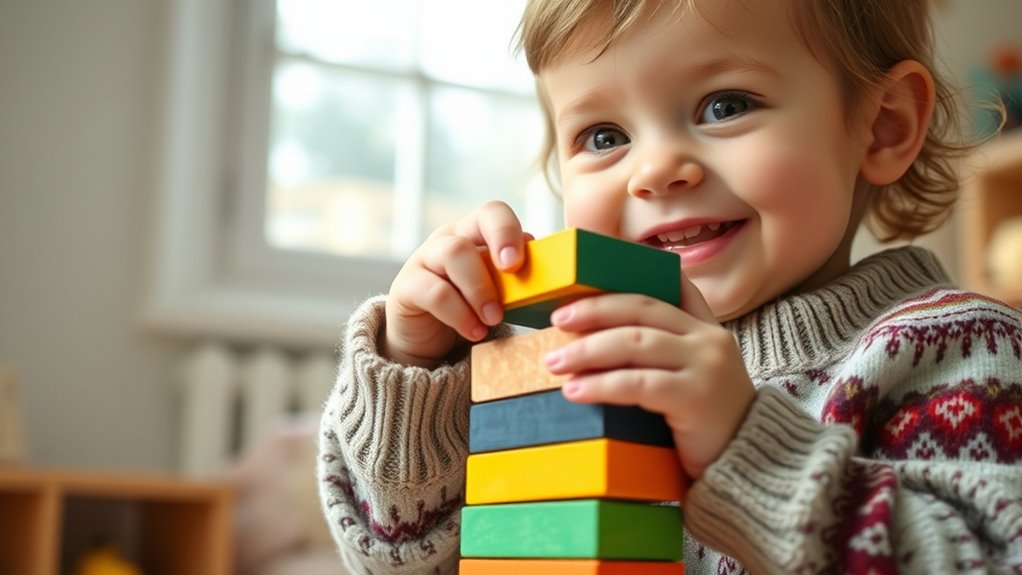
When your toddler repeatedly experiences the same routines, they begin to trust what’s familiar. This sense of trust helps them feel more secure as they explore new things. As they master skills through repetition, their confidence grows, making them more enthusiastic to try new challenges. Incorporating familiar activities like skincare routines can also provide a calming and predictable environment that supports their emotional development. Additionally, developing a predictable environment aligns with energy-efficient practices such as the use of heat pumps, which transfer heat efficiently and create a comfortable indoor climate.
Familiarity Fosters Trust
Familiarity plays a crucial role in helping toddlers feel safe and confident as they explore their world. When they experience repeated routines or familiar faces, it strengthens trust building and emotional security. This consistency reassures them that their environment is predictable and safe, allowing them to develop confidence in their abilities. As they recognize patterns and routines, they begin to understand what to expect, reducing anxiety and fostering a sense of control. This sense of trust encourages toddlers to take new steps, knowing they have a secure foundation to fall back on. Repetition also influences home furnishings, helping them become more comfortable with new experiences over time. Additionally, engaging in familiar activities can support their emotional security, making them more resilient to stress. Furthermore, understanding how behavioral patterns develop through repetition can guide caregivers in providing supportive environments that promote healthy growth. Recognizing the importance of consistent routines can further enhance their sense of stability and trust.
Mastery Boosts Self-Esteem
Practicing a skill repeatedly allows toddlers to see their progress and feel a sense of achievement. As they master new tasks, their self-esteem grows, reinforcing a positive self-image. Repetition helps children recognize their capabilities, which is essential for confidence building. When your toddler successfully completes an activity multiple times, they start to believe in their abilities, fostering a sense of security. This confidence encourages them to try new challenges, knowing they can succeed. Each small victory reinforces their belief that they can learn and improve. Over time, this mastery boosts their self-esteem, making them more willing to explore and take on new experiences. Repetition isn’t just about practice; it’s a powerful tool for nurturing your child’s confidence and emotional security. Additionally, consistent engagement with familiar activities can also create a sense of stability and routine, which further supports emotional development. Incorporating wall organization systems and decorative elements that are visually appealing can make familiar environments more stimulating and reassuring for toddlers.
Repetition and Skill Acquisition in Toddlers
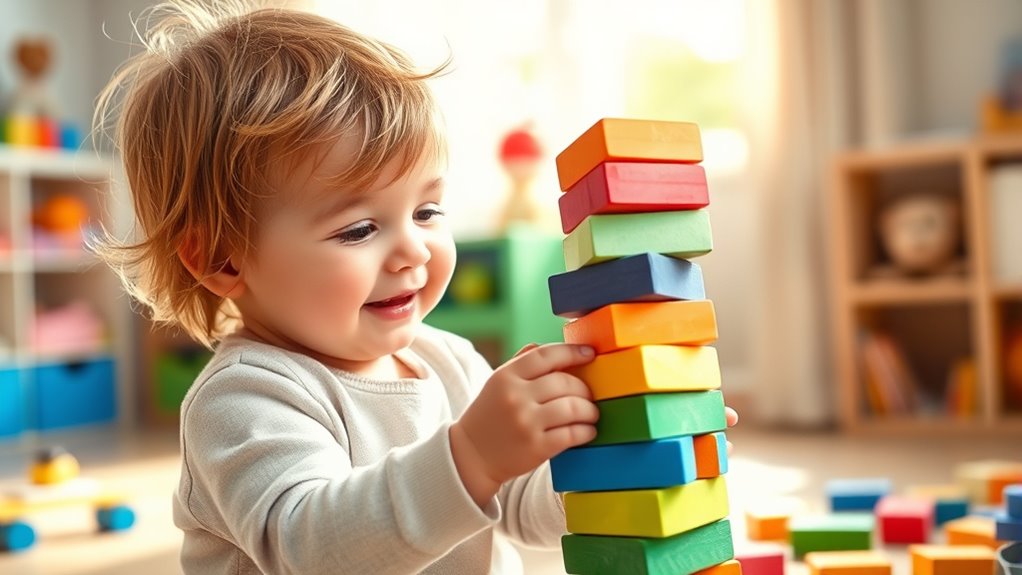
Repetition plays a crucial role in how toddlers acquire new skills, as it helps solidify neural connections and build confidence. When your toddler repeatedly engages with activities like exploring fantasy worlds or practicing musical preferences, they strengthen their understanding and mastery. Repetition encourages them to experiment, make mistakes, and improve, laying the foundation for future learning. By doing something over and over, they develop coordination and problem-solving skills essential for more complex tasks. You might notice your toddler enthusiastically revisiting favorite stories or songs, which boosts their confidence. To support this process, encourage activities such as:
- Repeating favorite songs or stories to reinforce memory
- Practicing simple tasks like stacking blocks or buttoning shirts
- Exploring different fantasy worlds through play and imagination
- Recognizing the importance of skill acquisition through consistent practice and understanding how brain development is influenced by repeated activities. Additionally, the increasing use of AI security in various fields underscores how repetition and continuous learning are vital for adapting to new challenges and improving performance.
The Connection Between Repetition and Language Learning
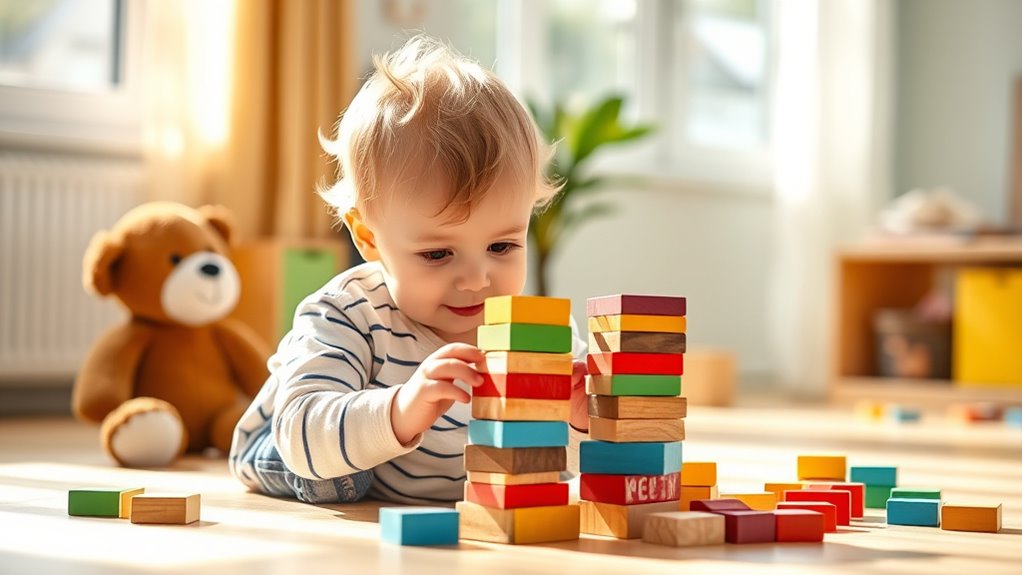
When you repeat words and phrases to your toddler, you help them learn vocabulary more quickly. This practice also boosts their confidence in speaking and improves their listening skills. Repetition creates a strong foundation for your child’s language development.
Reinforces Vocabulary Acquisition
Because young children learn best through consistent exposure, repeated language experiences help solidify new vocabulary in their minds. When your toddler hears words multiple times, it promotes vocabulary reinforcement, making those words stick. Repetition isn’t just about rote memorization; it helps children understand context and meaning. By hearing words repeatedly, they start associating sounds with objects or actions, which accelerates learning. This process builds a strong foundation for language development and encourages your child to use new words confidently. Remember, frequent exposure to familiar words keeps vocabulary fresh and accessible.
- Reinforces word meanings through practice
- Helps progression from recognition to active use
- Strengthens memory retention of new words
Builds Speech Confidence
Repeatedly hearing and practicing words encourages your toddler to speak with more confidence. As they repeat familiar words and phrases, they become more comfortable expressing themselves, which boosts their language development. This consistent practice helps reduce hesitation, making them more willing to try new words and sentences. Building speech confidence also supports emotional regulation; when your toddler feels successful in communicating, they experience less frustration and anxiety. Over time, this positive reinforcement strengthens their ability to navigate social interactions and express their needs clearly. Repetition creates a safe space for your child to explore language, helping them gain the confidence to communicate effectively. As they grow, this foundation encourages a lifelong love of language and learning.
Enhances Listening Skills
Repetition strengthens your toddler’s listening skills by helping them become more attuned to the sounds and patterns of language. When they hear the same words and phrases repeatedly, their auditory discrimination improves, allowing them to distinguish between different sounds more easily. This process also boosts listening endurance, so they can focus longer and absorb more language input. As they practice listening through repetition, your toddler learns to pick up subtle differences in pronunciation and intonation. To support this, engage them with activities that emphasize repeated words and sounds, such as singing songs or reading familiar stories. These experiences help solidify their ability to listen carefully, setting a strong foundation for language development.
- Improve sound recognition and differentiation
- Extend their attention span during conversations
- Build confidence in understanding spoken language
Recognizing Repetition as a Natural Learning Tool

Have you ever wondered why toddlers often repeat actions or words? Repetition is a natural part of their learning process, helping them make sense of the world. When your child repeats a movement or word, they’re engaging in sensory exploration, which helps develop their understanding of textures, sounds, and sights. It also supports emotional regulation, giving them comfort and a sense of control in new or overwhelming situations. Recognizing repetition as a learning tool allows you to see it not as boredom or stubbornness, but as a crucial way your toddler processes new information. By valuing these repeated behaviors, you encourage their curiosity and confidence. This understanding helps you support their growth, making learning both meaningful and enjoyable.
Supporting Toddler Repetition at Home and Play
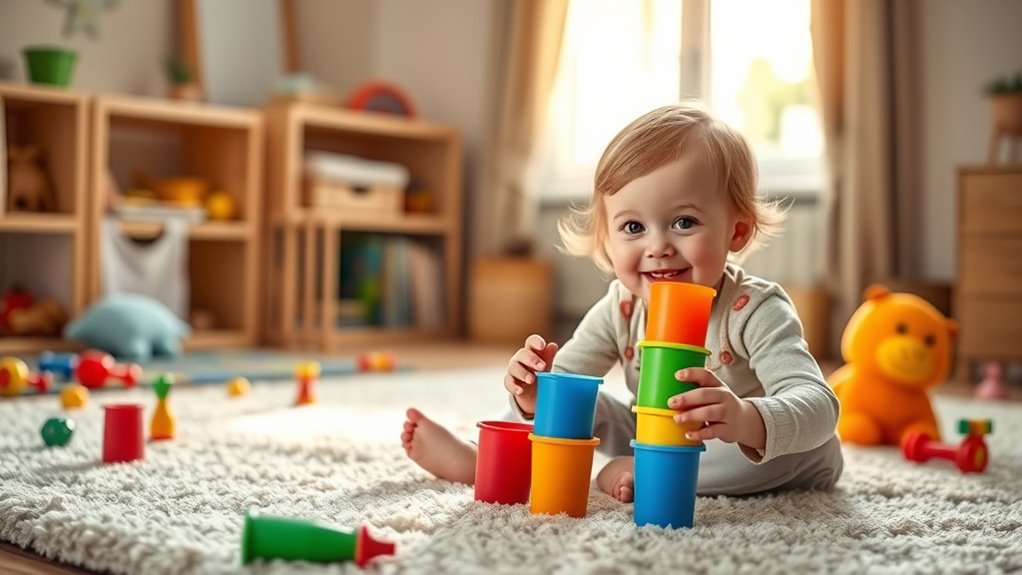
Wondering how you can encourage your toddler’s natural tendency to repeat actions during play and at home? Supporting this behavior helps build routine stability and boosts sensory exploration. You can do this by creating safe, inviting spaces where your child feels free to explore familiar activities repeatedly. Incorporate repetitive routines that make your toddler comfortable and confident, like reading the same book nightly or playing with the same toys. Encourage sensory exploration by offering textured materials or musical instruments that invite repeated interaction. Additionally, respond positively to their repeated actions, reinforcing their curiosity and learning. This approach fosters their confidence, provides stability, and enhances their sensory development through engaging, familiar experiences.
When Repetition Becomes a Sign of Developmental Milestones
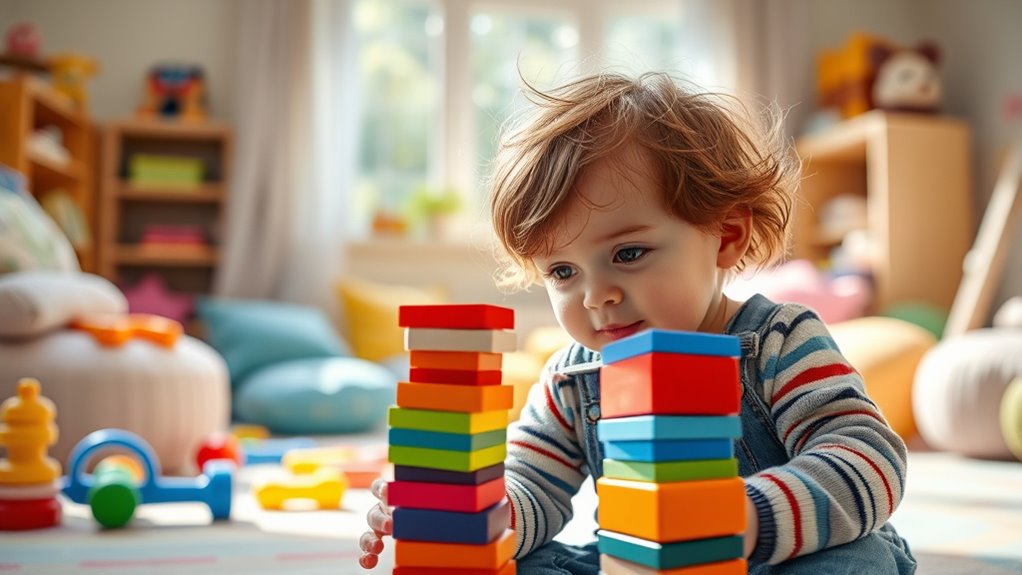
When a toddler begins to repeat certain actions more intentionally and frequently, it can signal important developmental milestones. This repetition often reflects improvements in motor skills, as your child practices coordination and control through actions like stacking blocks or jumping. It also highlights their growing sensory exploration, as they discover how different textures, sounds, and movements feel. Repetition helps toddlers solidify their understanding of their environment and build confidence in their abilities. You might notice them repeatedly pointing to objects or practicing sounds, which shows they’re developing communication skills. These behaviors are more than just play—they’re an essential part of their growth, indicating progress in both physical development and sensory awareness. Recognizing these signs can help you support their ongoing development effectively.
Encouraging Healthy Repetition While Fostering Creativity

Encouraging healthy repetition in your toddler involves guiding their natural tendencies toward exploration while nurturing their creativity. Repetition helps them develop skills, but it also offers opportunities for creative exploration and emotional expression. To foster this, provide open-ended activities that invite your child to experiment and imagine. Encourage them to add their own twists to familiar routines, making each experience unique. Use words and gestures to help them express emotions tied to their actions, supporting emotional development.
Support your toddler’s growth by encouraging creative repetition and emotional expression through open-ended activities.
- Offer versatile art supplies for open-ended projects that promote creative exploration
- Create routines where your toddler can add personal touches or variations
- Use storytelling and role-play to help your child express feelings and ideas creatively
Frequently Asked Questions
How Can Parents Differentiate Between Healthy Repetition and Potential Developmental Concerns?
You might wonder how to tell if your child’s repetitive behaviors are normal or a concern. Usually, healthy repetition helps achieve developmental milestones and provides parental reassurance. If your toddler’s interests suddenly change, or if repetition interferes with daily activities or social interactions, it could signal a developmental concern. Trust your instincts and consult a pediatrician if you’re worried; they can help differentiate between typical behavior and potential issues.
Are There Specific Activities That Naturally Encourage Beneficial Repetition in Toddlers?
You can encourage beneficial repetition in toddlers through activities like sensorimotor play, where they explore textures and objects, and language practice, such as reading familiar books or singing songs. These activities naturally promote repeated actions, helping your toddler develop motor skills and language. Repetition in these contexts supports their learning, builds confidence, and satisfies their need for consistency, making play both fun and educational.
How Does Cultural Background Influence a Child’s Desire for Repetition?
Your child’s desire for repetition is shaped by their cultural background, influencing their behaviors and preferences. Cultural practices and traditions often emphasize certain activities, making children more comfortable repeating them. Additionally, language influence plays a role; in some cultures, storytelling and song are central, encouraging children to revisit these repeatedly. By understanding these cultural factors, you can better support your child’s learning and emotional development through familiar, meaningful activities.
What Are Common Signs That a Toddler’s Repetition May Indicate Stress or Anxiety?
You might notice your toddler repeatedly asking for the same activity or showing unusual behaviors. These stress signals and anxiety cues can include tantrums, withdrawal, changes in sleep or appetite, or obsessive behaviors. If these signs persist or intensify, it’s important to comfort them and seek support. Recognizing these cues helps you address their emotional needs and create a calming environment, easing their stress and reducing repetitive behaviors caused by anxiety.
How Can Caregivers Balance Encouraging Repetition With Promoting New Experiences?
You can balance encouraging repetition and promoting new experiences by setting creative boundaries that allow your toddler to enjoy familiar activities while gently introducing new ones. Offer emotional support by praising their efforts and providing reassurance during shifts. This approach helps your child feel secure, fosters curiosity, and nurtures their development. Remember, a mix of consistent routines and exciting new activities helps your toddler grow confident and adventurous.
Conclusion
As you watch your toddler fervently spin the same toy or repeat a song, imagine planting tiny seeds of confidence and curiosity in their mind. Each loop and encore shapes their world like brushstrokes on a vibrant canvas. Embrace their love for repetition, knowing you’re nurturing a resilient, confident learner. Together, you’re building a colorful, lively tapestry of growth—one joyful, repeated moment at a time.

